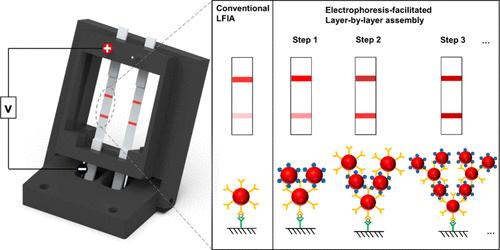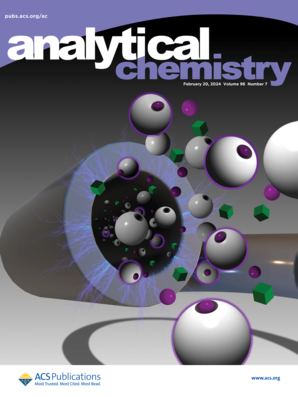IF 6.7
1区 化学
Q1 CHEMISTRY, ANALYTICAL
引用次数: 0
摘要
在横向流动免疫测定(LFIA)中,金纳米粒子(GNPs)通过电泳促进逐层组装,大大提高了信噪比,从而提高了这些测试的诊断灵敏度。然而,传统的纸上双贮槽电泳受到毛细管作用引起的逆流的限制,这种逆流会干扰 GNPs 向阳极的电泳迁移。这种逆流需要人工干预,以促进 GNP 标记的免疫复合物从膜移动到吸收垫,从而使检测工作流程复杂化。为了解决这一难题,我们提出了一种非常规的纸上单贮槽电泳系统,它从本质上消除了逆流现象。在这种配置中,纸条的装载侧和阴极位于缓冲液槽内,而阳极则直接贴在纸条的另一端。我们展示了这种单储液器系统在推动逐层组装方面的功效,同时还带来了有利的空间温度曲线。这种设计无需人工操作,简化了电泳过程,提高了电泳促进 LFIA 检测的可用性。本文章由计算机程序翻译,如有差异,请以英文原文为准。

Single-Reservoir Electrophoresis to Facilitate Layer-by-Layer Assembly of Gold Nanoparticles in Lateral Flow Immunoassay
Electrophoretically facilitated layer-by-layer assembly of gold nanoparticles (GNPs) in lateral flow immunoassays (LFIAs) significantly enhances the signal-to-background ratio and, consequently, the diagnostic sensitivity of these tests. However, conventional two-reservoir electrophoresis on paper is limited by counterflow induced by capillary action, which disrupts the electrophoretic migration of GNPs toward the anode. This counterflow necessitates manual intervention to facilitate the movement of GNP-labeled immunocomplexes from the membrane to the absorption pad, complicating the assay workflow. To address this challenge, we propose a nonconventional single-reservoir electrophoresis system on paper, which inherently eliminates counterflow. In this configuration, the loading side of the paper strip and the cathode reside within the buffer reservoir, while the anode is directly affixed to the opposite end of the paper strip. We demonstrate the efficacy of this single-reservoir system in driving layer-by-layer assembly, while presenting favorable spatial temperature profiles as a side benefit. By eliminating the need for manual steps, this design streamlines the electrophoresis process and enhances the usability of electrophoretically facilitated LFIA assays.
求助全文
通过发布文献求助,成功后即可免费获取论文全文。
去求助
来源期刊

Analytical Chemistry
化学-分析化学
CiteScore
12.10
自引率
12.20%
发文量
1949
审稿时长
1.4 months
期刊介绍:
Analytical Chemistry, a peer-reviewed research journal, focuses on disseminating new and original knowledge across all branches of analytical chemistry. Fundamental articles may explore general principles of chemical measurement science and need not directly address existing or potential analytical methodology. They can be entirely theoretical or report experimental results. Contributions may cover various phases of analytical operations, including sampling, bioanalysis, electrochemistry, mass spectrometry, microscale and nanoscale systems, environmental analysis, separations, spectroscopy, chemical reactions and selectivity, instrumentation, imaging, surface analysis, and data processing. Papers discussing known analytical methods should present a significant, original application of the method, a notable improvement, or results on an important analyte.
 求助内容:
求助内容: 应助结果提醒方式:
应助结果提醒方式:


